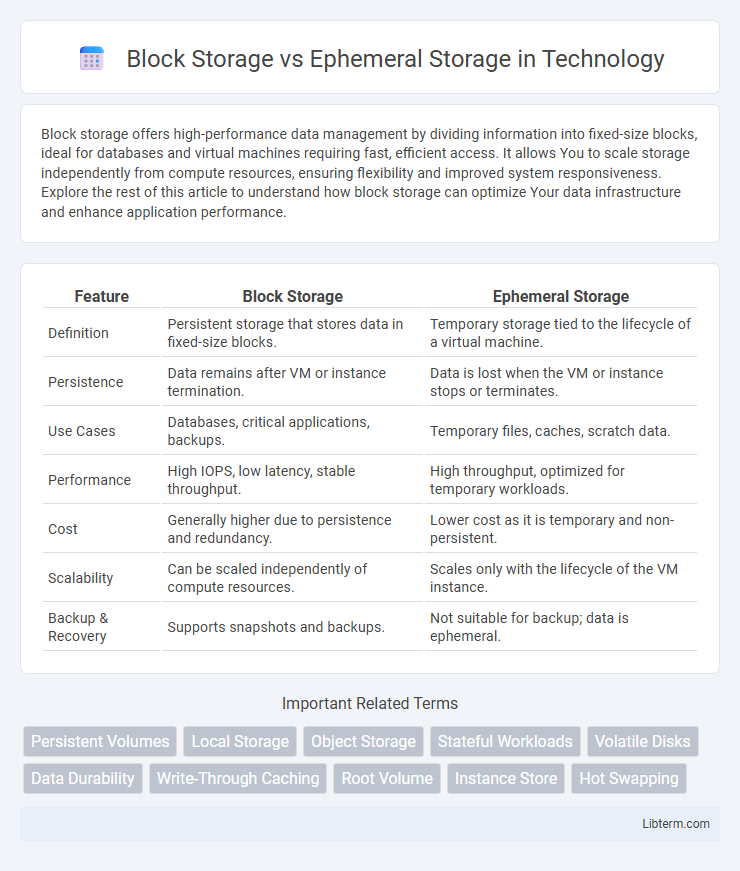Block storage offers high-performance data management by dividing information into fixed-size blocks, ideal for databases and virtual machines requiring fast, efficient access. It allows You to scale storage independently from compute resources, ensuring flexibility and improved system responsiveness. Explore the rest of this article to understand how block storage can optimize Your data infrastructure and enhance application performance.
Table of Comparison
| Feature | Block Storage | Ephemeral Storage |
|---|---|---|
| Definition | Persistent storage that stores data in fixed-size blocks. | Temporary storage tied to the lifecycle of a virtual machine. |
| Persistence | Data remains after VM or instance termination. | Data is lost when the VM or instance stops or terminates. |
| Use Cases | Databases, critical applications, backups. | Temporary files, caches, scratch data. |
| Performance | High IOPS, low latency, stable throughput. | High throughput, optimized for temporary workloads. |
| Cost | Generally higher due to persistence and redundancy. | Lower cost as it is temporary and non-persistent. |
| Scalability | Can be scaled independently of compute resources. | Scales only with the lifecycle of the VM instance. |
| Backup & Recovery | Supports snapshots and backups. | Not suitable for backup; data is ephemeral. |
Introduction to Block Storage and Ephemeral Storage
Block storage stores data in fixed-size blocks, enabling fast, persistent access ideal for databases and virtual machines. Ephemeral storage provides temporary, non-persistent storage that exists only during the lifecycle of a virtual instance or container. Cloud environments commonly use block storage for long-term data retention and ephemeral storage for short-term tasks and cache.
Key Differences Between Block and Ephemeral Storage
Block storage provides persistent, high-performance data storage ideal for databases and virtual machines, allowing data to be stored in fixed-size blocks accessible independently. Ephemeral storage offers temporary storage tied to the lifecycle of a virtual instance, losing data when the instance is terminated, making it suitable for caching or scratch data. Key differences include data persistence, with block storage retaining data beyond instance termination, whereas ephemeral storage is non-persistent and local to the instance.
Architecture Overview: Block Storage
Block Storage architecture organizes data into uniformly sized blocks, each with a unique identifier accessible independently over a storage network. It operates at the storage area network (SAN) level, enabling high-performance data access with low latency, suitable for databases and virtual machines. The architecture supports persistent storage, allowing blocks to be stored persistently across sessions, unlike ephemeral storage which is temporary and tied directly to the lifecycle of a specific instance.
Architecture Overview: Ephemeral Storage
Ephemeral storage architecture relies on temporary, physically attached storage devices within a compute instance, providing high-speed data access that is lost upon instance termination or failure. This storage type is ideal for workloads requiring low-latency read/write operations, such as caching and buffering, but lacks persistent data retention across instance lifecycles. Ephemeral storage often integrates tightly with the host server's local disks, ensuring minimal overhead and optimized I/O performance in cloud environments.
Performance Comparison: Block vs Ephemeral Storage
Block storage offers consistent high performance suitable for databases and applications requiring low latency and high IOPS, while ephemeral storage delivers faster data access speeds but with temporary data persistence limited to a single session. Block storage supports persistent data with scalable throughput, making it ideal for long-term storage needs, whereas ephemeral storage prioritizes speed and performance for transient workloads without durability. Performance differences hinge on workload requirements, with block storage excelling in reliability and continuous operation, and ephemeral storage optimizing for short-lived, high-speed data processing tasks.
Data Persistence and Durability
Block storage offers persistent data storage by maintaining data independently of the virtual machine lifecycle, ensuring high durability through replication and snapshot capabilities. Ephemeral storage provides temporary storage tied to the instance's lifespan, resulting in data loss upon instance termination or failure. Persistent block storage is essential for critical applications requiring long-term data retention and recovery guarantees.
Use Cases for Block Storage
Block storage offers persistent, high-performance data storage suitable for databases, virtual machines, and enterprise applications requiring reliable, low-latency access. It supports transactional workloads, enabling consistent data integrity and rapid recovery in case of system failures. Use cases include cloud databases like Amazon EBS, VMware virtual disks, and mission-critical applications needing durable, scalable storage solutions.
Use Cases for Ephemeral Storage
Ephemeral storage is ideal for temporary, high-speed data processing tasks such as caching, session storage, and scratchpad operations where data persistence is not critical. It excels in scenarios like containerized applications, CI/CD pipelines, and batch processing jobs that require fast I/O performance without long-term durability. Use cases often leverage ephemeral storage for real-time analytics, temporary file storage during data transformation, and stateless workloads in cloud environments.
Cost Implications and Scalability
Block storage offers higher scalability and persistent data retention, making it ideal for databases and applications requiring long-term storage, but its costs increase with capacity and performance needs. Ephemeral storage provides cost-effective, temporary storage tied to the lifecycle of a compute instance, suitable for caching and scratch data, but it lacks persistence and scalability beyond the instance limit. Enterprises must balance block storage's higher cost and scalability with ephemeral storage's affordability and limited durability depending on workload demands.
Choosing the Right Storage for Your Needs
Block storage offers persistent, high-performance data storage ideal for databases and virtual machines requiring reliable, long-term access, while ephemeral storage provides temporary, low-latency storage suited for transient data and compute instances with short lifespans. Evaluating factors such as data durability, backup requirements, workload persistence, and cost efficiency is crucial in selecting between block and ephemeral storage solutions. Prioritizing use cases that demand consistent availability or temporary cache-like storage ensures optimal resource allocation and system performance.
Block Storage Infographic

 libterm.com
libterm.com